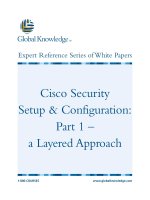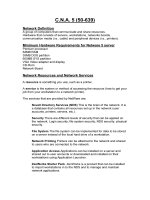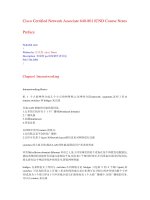Tài liệu Cisco Systems - Spanning - Tree protocol overview docx
Bạn đang xem bản rút gọn của tài liệu. Xem và tải ngay bản đầy đủ của tài liệu tại đây (455.23 KB, 16 trang )
© 2002, Cisco Systems, Inc. All rights reserved.
© 2002, Cisco Systems, Inc. All rights reserved. ICND v2.0—3-2© 2002, Cisco Systems, Inc. All rights reserved. 2
Spanning-Tree Protocol
Overview
© 2002, Cisco Systems, Inc. All rights reserved. ICND v2.0—3-3
Objectives
Upon completing this lesson, you will be
able to:
•
Describe the purpose and operation of the STP
•
Explain how to implement STP to solve the
problems associated with redundant switched
or bridged topologies
© 2002, Cisco Systems, Inc. All rights reserved. ICND v2.0—3-4
•
Provides a loop-free redundant network topology by
placing certain ports in the blocking state.
Spanning-Tree Protocol
© 2002, Cisco Systems, Inc. All rights reserved. ICND v2.0—3-5
•
One root bridge per network
•
One root port per nonroot bridge
•
One designated port per segment
•
Nondesignated ports are unused
Spanning-Tree Operation
© 2002, Cisco Systems, Inc. All rights reserved. ICND v2.0—3-6
•
Bpdu = Bridge Protocol Data Unit
(default = sent every two seconds)
•
Root bridge = Bridge with the lowest bridge ID
•
Bridge ID =
•
In the example, which switch has the lowest bridge ID?
Spanning-Tree Protocol
Root Bridge Selection
© 2002, Cisco Systems, Inc. All rights reserved. ICND v2.0—3-7
•
Spanning-tree transits each port through
several different states:
Spanning-Tree Port States
© 2002, Cisco Systems, Inc. All rights reserved. ICND v2.0—3-8
Spanning-Tree Port States (Cont.)
© 2002, Cisco Systems, Inc. All rights reserved. ICND v2.0—3-9
Spanning-Tree Path Cost
© 2002, Cisco Systems, Inc. All rights reserved. ICND v2.0—3-10
Spanning-Tree Example
© 2002, Cisco Systems, Inc. All rights reserved. ICND v2.0—3-11
Spanning-Tree Recalculation
© 2002, Cisco Systems, Inc. All rights reserved. ICND v2.0—3-12
Spanning-Tree Convergence
•
Convergence occurs when all the switch and
bridge ports have transitioned to either the
forwarding or the blocking state.
•
When the network topology changes,
switches and bridges must recompute the
Spanning-Tree Protocol, which disrupts user
traffic.
© 2002, Cisco Systems, Inc. All rights reserved. ICND v2.0—3-13
Rapid Spanning-Tree Protocol
© 2002, Cisco Systems, Inc. All rights reserved. ICND v2.0—3-14
Rapid Transition to Forwarding
© 2002, Cisco Systems, Inc. All rights reserved. ICND v2.0—3-15
Summary
•
STP is a bridge-to-bridge protocol used to maintain a
loop-free network.
•
STP establishes a root bridge, a root port, and designated
ports.
•
With STP, the root bridge has the lowest bridge ID, which
is made up of the bridge’s priority and MAC address.
•
With STP, ports transition through four states: blocking,
listening, learning, and forwarding.
•
If a change occurs to the network topology, STP
maintains connectivity by transitioning some blocked
ports to the forwarding state.
•
RSTP significantly speeds the recalculation of the
spanning tree when the network topology changes.









